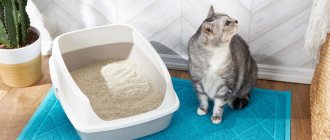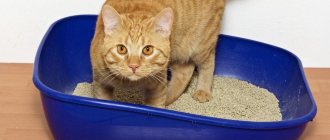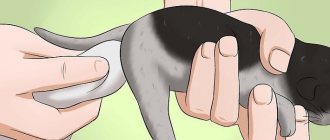Why do cats tear furniture and wallpaper?
Over the millennia of living side by side with humans, furry domestic predators have not lost any of their wild habits. Like all representatives of the cat family, domestic purrs constantly keep their main weapon at the ready - sharp curved claws. They are constantly growing, so the animal needs to constantly remove old parts. To do this, they “sharpen” them, that is, they remove roughened and exfoliating particles using various objects.
In nature, these are most often snags and tree trunks, and the claws are also worn down when moving on hard, dry soil. But there are no conditions for this at home, so there are only two options left - get a high-quality scratching post or regularly trim them yourself or from a groomer or veterinarian. The third option - tolerating torn curtains, tattered furniture and damaged carpets - is unlikely to suit anyone.
A scratching post is the best solution. The animal gets the opportunity to sharpen its claws in a natural way, and the owners get a chance to save their interior. It is only important to choose the right device and figure out how to accustom a cat to a scratching post.
Why start with a cat scratching post?
So, as soon as a kitten appears in your family, a sea of pleasant troubles immediately forms around it. How to ensure peace and comfort for your pet, how to make adaptation as gentle as possible. And the owners themselves need to get used to the idea that they are not alone now. One of the important elements of organizing the life of a family with an animal is arranging a space for the animal.
It is quite natural for cats to sharpen their claws on everything that comes to hand, or rather, under their paw. But at home you can only find the owner’s sofas, armchairs, and cabinets. A claw for cats is a kind of compromise between the cat and the owner. But usually, when we come to the store to buy a gift for our pet, we are simply lost: there are so many of them, and they are so different. But a cat scratcher is chosen based on the character and temperament of your bully.
Your pet's character will reveal itself very quickly. And like all new cat lovers, you will be faced with the problem of your cat’s sharp claws, from which furniture, wallpaper, carpets and other things pleasing to the heart and wallet will suffer.
To avoid these troubles, you need to buy a scratching post for your cat.
Experts have still not come to a common opinion as to why cats scratch their claws on any suitable surface. Perhaps this is a hunting instinct or a cosmetic procedure to help get rid of claw problems. In any case, this instinct cannot be reversed, you can only direct it in a peaceful direction.
You can have surgery to remove the claws or use silicone caps permanently. We recommend taking the simple route - purchasing a scratching post. This will cost less and the pet will not experience any inconvenience.
Today, manufacturers offer a wide range of different models of scratching posts. These devices come both separately and in combination with play complexes and houses for cats. Of course, the second option is more functional; the scratching post with a cat bed is multipurpose, but the first is much cheaper.
How to choose?
So, you need to start... with the breed of your pet. Agree that a big cat needs a different scratching post than a small one. And if you know that your pet will grow to the size of a small hippopotamus, there is no point in buying him a small cone-scratching post, he will quickly outgrow it, and the issue will become relevant again.
Unfortunately, a cat scratcher can become an unnecessary dust collector if the cat doesn’t like it. In order for your cat to need it, you should take a closer look at what kind of furniture he breaks more often than others. Or maybe he prefers wallpaper or carpet? In this case, it is better to choose a machine with carpet flooring. If the cat doesn’t have any special preferences, you should choose a floor or corner one so that you can take it with you or rearrange it. And most importantly, it must be sustainable.
It is possible to take a scratching post specifically for a kitten, but you need to understand that as the animal grows, you will need to change the scratching post.
If you are not sure what size your pet will reach, we recommend that you immediately take a flat, high cat scratching post that is mounted on the wall. Or choose a flat, floor-standing scratching post. This type of device is universal and can be used by both small kittens and large cats.
If you choose the option of combining a scratching post with play complexes or a house, then you solve several problems at once: saving furniture, organizing a place for relaxation and space for games. Today there are a lot of offers of such complexes on the market. We recommend paying attention to the Lapahvost store. Prices for scratching posts and play complexes are among the lowest on the market. Pleasant delivery conditions and constant promotions. Compare and make the choice yourself.
So, you can imagine what kind of cat scratching post you would like. Now you need to choose the material from which it will be made. The most common scratching post models on the market are those with sisal or jute winding. They are environmentally friendly, do not require special care, and cats love this material very much. Scratching posts for large cats have a sisal winding. It holds the weight of the animal well, the cat can climb for pleasure without danger.
There are also carpet scratching posts on the market. Most often they are equipped with fur, toys, and the basis of such a scratching post is carpet. Some cats love to sharpen their claws on this type of covering, and you can save your sofa by purchasing this model.
Variants of scratching posts, their types
First of all, you need to take into account the functional characteristics:
- Claw sharpener for cats, pole type. This is a kind of exercise machine, because in addition to its main function, it develops and warms up the back, strengthens the muscles and shoulder joints, and helps the old nail plate to naturally peel off. The optimal height of the simulator is 70 cm (for kittens – 50).
- House. This scratcher for cats is universal: not only housing, but also a post for claws. It is better if such a booth has a size of 30x30 cm.
- Game complex. This is not a cat scratcher, but a whole park: tunnels, passages, stairs... With this, not only will you not want to scratch your claws on the furniture, but you will also not want to climb the curtains and knock down everything that is on the furniture to the ground. One disadvantage of such a claw clipper for cats is that it is very expensive.
- It is also worth paying attention to the material.
- Cardboard nail clippers for cats are the most inexpensive. This layered design won't last long, but this scratching post is eco-friendly.
- Jute ones are also inexpensive, but cats usually like them.
- Sisal. More expensive than jute. But the pleasure for the cat will also last longer.
- Wooden.
Which upholstery should I choose?
But for a cat, upholstery is most important. It can be carpet (suitable for those who like to tear up carpets), furniture fabric, faux fur and plush.
Pay attention to the location of the cat scratcher.
Flooring is usually made of cardboard, sisal or carpet. It's just a board or rug. The good thing is that you can easily move it and even take it with you. A house and a column can be called floor-standing.
Wall-mounted scratching posts for cats are good because they are attached once, in one place, the cat gets used to scratching its claws only in one corner and no longer encroaches on other furniture. And also because they can be placed exactly in the place of the apartment that the cat has chosen for his “exercises”: using a self-tapping screw, you can screw it on the wall, on the tiles in the bathroom or on the door. In case of difficult adaptation, you can use the floor one and constantly move it to the animal’s “favorite places”.
The wall-mounted scratching post can be of several variations: corner, extended, supplemented with toys. It is suitable even for tall and large cats.
Angular. They are hung or placed in the corner. A corner house can be either a house or a play complex.
Optimal house arrangement
In order for a pet to recognize a new home, it must meet special cat standards:
- Dimensions . A cat needs comfort and protection, so you need to carefully select housing according to the size of your pet. If the house is cramped or too large, the animal will refuse to spend the night in it.
- Quality of material . There is no need to save; preference is given to frames made from natural components - wood. Make sure that the upholstery fabric is soft, pleasant to the touch, and does not electrify, otherwise your pet will refuse to live in the house. Plush and carpet are the most acceptable; other natural fabrics can also be used. Synthetic padding and foam rubber are used as padding for the bed. A good option would be a homemade mattress made from familiar materials. Use an old shirt or robe that your pet likes to lie on. If he has a familiar bedding, move it into the house, making it easier to get used to.
- Smell . Before purchasing, sniff the house. There should be no strong odors; do not forget that a pet’s sense of smell is sharper than a human’s. If the housing emanates aromas of glue and low-quality materials, the fluffy will refuse to enter it.
- Sustainability . Cats are frightened by shaky structures, so check the security of the housing and secure it carefully. If an animal gets scared once in the house, it will ignore it in the future.
- Installation location . Place your pet's home in a secluded corner, not in the aisle. Cats love it when there is a radiator nearby - this provides comfort in winter, but you should not place the structure too close to the heating device - overheating causes molting.
- Emergency exits . The instinct of a predator makes fluffies care about their safety, so a house with several holes will be to their liking.
- Ventilation . Cats love ventilated rooms, so that unpleasant odors do not accumulate, and a comfortable temperature in summer and winter.
- Functionality . Pets are attracted not only by cozy, but also interesting designs - cats are very curious. It could be a multi-story structure with labyrinths. The pussy will be interested in an open complex with a scratching post. Metal parts will not only attract attention, but also ensure the stability and safety of the structure.
- Gender characteristics . Consider the gender of the cat when choosing a design. Males, by nature, must control the surrounding space, so houses on stands, with several tiers in height, are suitable for them. Females care for their young and tend to live in cozy, enclosed spaces.
Where to place the scratching post?
Initially, the most correct location for the claw grinder will be exactly the place that the cat has already liked to sharpen its claws. At first, the sofa or corner of the wall must be covered with something, or, if possible, the animal’s access to these places must be completely limited. Draw your pet's attention in every possible way to such a new piece of furniture as a scratching post.
How to train a cat to scratch it? First, call your pet to the drape or lure it with a game. Place the paws on the surface and gently press them so that the cat extends its claws into the upholstery material. Talk to her kindly, praise her, give her her favorite treat. The animal is unlikely to understand what’s what the first time, be patient and repeat this procedure several times a day.
Every time your pet tries to scratch in the wrong place, pick him up and take him to the scratching post. Move the cat's paws along the drape again, tease with the toy to provoke it to release its claws into the upholstery. And reward the animal every time for the correct reaction.
Over time, when the problem of how to train a cat to sharpen its claws on a scratching post has been solved, and the correct habit has been developed, gradually move the drape to the place that you have previously thought up for it. If the house where the cat lives is quite large, then it is better to get several scratching posts and place them in different places. One of them should definitely be placed near the place where the pet sleeps or spends the most time.
Method one: take it out of curiosity
Although the tailed ones are conservative, no one has canceled the cat’s curiosity. A new object in the house will definitely interest the cat, and the owner’s task is to reinforce this interest. This can be done by placing the purr's favorite treat or her favorite toy inside the new home. Do this regularly and your cat will develop a positive association with the house. At first she will simply visit it from time to time, and over time she will begin to sleep in it - at first from time to time, and then constantly.
So, how to train a cat to use a scratching post?
Start training from birth
Of course, this advice will be superfluous for those who are trying to accustom an adult cat to a scratching post. However, things are easiest with kittens - it is much easier to teach desirable behavior than to correct unwanted behavior in the future.
It is not always possible to quickly accustom a kitten to a scratching post, but it is advisable to start training from infancy. Babies, as a rule, are interested in everything new; you just need to install the toy, show it to the kitten and encourage him every time he sharpens his claws on it. Very quickly it will turn into the only place where the baby will have fun in this way.
How to accustom a kitten to a scratching post at 1.5 months? Fast - no way. At this age, kittens are still completely unintelligent, and any upbringing requires methodology and perseverance. However, this is quite a suitable age to start learning.
Find the right height
One of the reasons why cats love to scratch is because they can extend their paws and extend their claws. Make sure the scratching post is mounted high enough so that the cat can stretch out to its full height.
If you are thinking about how you can accustom a small kitten to a scratching post, try starting with the posts to which the toys are attached. With a high probability, they will quickly interest the baby.
Secure the scratching post firmly
If the scratcher is simply leaning against the wall or is not stable enough, the cat will not use it.
Try different coatings
Coating is one of the most important characteristics. All cats are different, and what suits one may not please another.
Choose the angle of inclination
Each cat's personal preferences are different. Some people like a horizontal surface, some like a vertical one. Most people prefer a medium inclination angle.
Use the 1+1 rule
It means that each cat in the house should have its own scratching post, plus one extra for everyone. Scratching is one way to mark territory to make your cat feel safe. And if one of the pets has already “marked” a new object, the others will quite possibly choose another place for themselves - for example, your sofa.
Choose the right place
Since scratching is a way of marking territory, do not put the scratching post somewhere in the far corner (at least while you are trying to accustom an adult cat to a scratching post). It is best, of course, to install it close to the place that the cat has already chosen. In addition, you can place the toy near the sleeping area - most cats like to “sharpen their claws” when they wake up. Another convenient place is next to the front door, as cats perceive it as a territory boundary.
Don't forget about positive reinforcement
This will especially help if you are deciding how to train an adult cat to use a scratching post. Place treats around the scratching post, sprinkle catnip on the cover, and try to play with your cat (like a “fishing rod”) nearby so she can run around and jump on the scratching post. Very quickly the animal will understand that putting its claws into a new toy is quite pleasant - especially if after this you praise it every time!
Explain how to use the new toy
Just take your cat's paw and use the scratching post to scratch it. As long as the cat agrees to endure it, imitate scratching and be sure to praise it. The point is that a smell remains in the coating, which in the future will teach the cat to “sharpen its claws” in the right place.
Prohibit scratching anything else in the house
This of course won't work when the cat is left alone. However, she should know that such behavior is undesirable. Most animals just need to shout loudly or clap their hands; some have to be driven off with water from a spray bottle.
Destructive cats can be a lot of trouble. But if you carefully read our tips and are patient and persistent, your pet’s bad habit will soon remain just a memory!
How to train a cat to use a scratching post?
Ways to encourage
- Praise. When an animal scratches the scratching post, the owner needs to praise and pet the pet. You shouldn’t skimp on your enthusiasm – cats are no less susceptible to flattery than people. The beast will put on a show to get some attention.
- A game. When you first get acquainted with a new piece of furniture, you need to interest the kitten: play with a moving toy (candy wrapper, fishing rod) next to the scratching post. If during the process the baby accidentally catches his claws on the surface, he will quickly understand what the scratching post is intended for.
- Smell. If the pet stubbornly ignores the accessory, use smells that attract cats.
The surface is treated with regular valerian or catnip. There are industrial sprays for this task:
- Play Spray, Beaphar (valerian extract);
- "Scratch Here", Himola (catnip);
- "Smart Spray. Accustoming cats to scratching posts and places to play,” Api-San.
It is more difficult to wean your pet from destroying furniture, but with proper patience it is possible.
Methods of suppression
If the cat starts to tear up the sofa in the presence of the owners, you can let him know that this is not allowed.
Corporal punishment should be avoided; simply scaring the animal is enough:
- You can hold a tin of coins or another object that makes a noise under your hands, and accompany this noise with a stern shout.
- Use a spray bottle with water.
You cannot spank a cat with your hand or a newspaper, or punish it when it has stopped sharpening its claws. It is important to intervene at the very beginning of the process.
Cats don't like the scent of citrus fruits, but people like it. So you can spray vulnerable parts of the furniture with aromatic oils (add a few drops to a bottle of water).
Suitable:
- tangerine,
- lemon,
- orange,
- eucalyptus.
You can purchase commercial cat repellent sprays. They are applied to surfaces every day until the habit of tearing the claws elsewhere is established.
- “The Neatist”, Le Artis;
- Stop-it Cat, Beaphar;
- Nature's Miracle, 8 in1;
- "Mr.Fresh." Scratch protection", Ecoprom;
- “Smart spray. Protection against chewing and scratching for cats", Api-San.
The composition of the products may be different, and the effect may vary due to the individual characteristics of each pet. If one spray doesn't work, another may help.
The American product from the company 8 in 1 contains exclusively essential oils (cinnamon, lemongrass), and the spray from the European company Beaphar contains methyl nonyl ketone (found in fragrant rue, but also synthesized chemically).
Since the owner cannot be at home all the time, and the use of sprays cannot guarantee a 100% effect, the most reliable way to protect furniture is to make it disgusting from the cat’s point of view:
- The easiest way is to cover your favorite places with double-sided tape. After one attempt to sharpen its claws on a sticky surface, the animal will not touch it again.
- Instead of tape, you can buy special Sticky Paws tape.
- If the furniture has already been damaged, a good solution may be removable covers made of elastic fabric that will hide the traces of the crime. Cats do not sharpen their claws on stretchy material, and the covers are convenient to wash or replace with new ones.
If you plan to buy a new sofa, then they give preference to upholstery made from fabrics in which there is no interlacing of threads - then snags will not form, and it is inconvenient for the cat to exercise its claws:
- flock with Teflon impregnation;
- velours;
- relax (artificial suede with stretch effect).
Basic requirements for a cat's home
A special bed or a whole house can be purchased at a specialized store. The advantages of having your own home for a pet are the absence of co-sleeping with the owner (the kitten will not disturb its owner’s sleep). And also, if a cat is sick, they will not hide in corners or under sofas. During the illness, the animal will sleep in its house and it will not be difficult for the owner to notice changes in the behavior of his mustachioed pet.
Just buying a house and waiting for the cat to want to live there is not enough. It is important to properly accustom the animal to its place, observing persistence and patience. Only in this case will it be possible to convince the animal that it is important to follow the rules established by humans.
Note! It has been proven that young animals adapt well to everything new. But an adult can also be accustomed to a place prepared for it.
A house that does not comply with certain rules will never be able to please a pet, even if the person goes to all sorts of tricks. When buying a home for a cat, you need to carefully select it according to certain parameters, depending on the preferences of a particular pet.
Popular questions
Does your cat want to sharpen her claws on the scratching post?
It happens that a cat ignores the scratching post. Perhaps he doesn't like her and needs someone else. If you don't mind the money, you can buy another one and check it out. Another option is to sprinkle the scratching post with catnip, which cats love so much. Just don’t overdo it, because mint stimulates the nervous system. As soon as the cat falls in love with the scratching post, the mint should be discontinued.
Similar actions can be done with valerian. You can also buy a special spray for accustoming to the scratching post: it will put the cat in a playful mood and he will love the right place. Another method is to take the scratching post into a house with other animals and have the other cat sharpen its claws. This way she will leave her mark there, and when you bring the scratching post home, your cat will want to re-mark this place.
Does your cat sharpen its claws everywhere?
It also happens that a cat loves a scratching post, just like other places in the apartment. There are several solutions to this problem. The simplest thing is to block the cat’s access to his favorite place with some object. You can also spray with special sprays that repel cats. They usually have citrus smells, which tailed animals don't like.
But the trouble is that these repellers do not work for many. An unpleasant, but effective option is to spray the cat with a spray bottle every time he tries to do something he shouldn’t. But there are costs here. The cat is not a fool, he will remember that it is impossible only when the owner sees, that is, when he does not see, it is possible. As a result, your furniture will still be tattered.
Cats are masters of doing dirty tricks on the sly. Or maybe the opposite situation occurs - the cat sharpens its claws where it should not, only in the presence of the owner. This is already a psychological problem and it means that in this way the cat wants to draw your attention to himself. This is some kind of manipulative technology.
One day the cat noticed that no matter what he did, the owner was busy with something and did not pay attention to him, but as soon as he did something forbidden, suddenly his person was in demand. He will remember this situation and now every time he will try to get you with the point of his claws or other unwanted action. If so, then we can only congratulate you.
You will have to either fence off the object of damage, or try to sit out the cat, completely ignoring it. By doing this, you will make it clear that the manipulative technology does not work - and the pet will remain empty-handed, after which it will leave its occupation. Do not forget that sharpening the claws on objects is also a way to mark the territory due to the marks left behind and a special secret that stands out on the pads. Accordingly, another reason why a cat can tear up everything is marks. And this means that he does not feel very confident in your apartment. Think about why exactly and try to fix it.
Video
Method three: light pressure plus encouragement
A particularly stubborn cat must be housetrained with gentle pressure. Take the cat (do it softly and affectionately) and put it in the house. Caress her, give her a treat, but don’t insist too much, don’t try to keep her there by force. Just repeat this procedure from time to time, and soon the cat will begin to perceive the house as a place where it feels comfortable.
Video: how to house train a kitten
All cats are individual - some begin to sleep in the house from the day of purchase, and there are those that never recognize their new home. In any case, remember - a cat cannot be forced to do something. Only affection and encouragement (and sometimes cunning) will help convince the purr to do your way.











